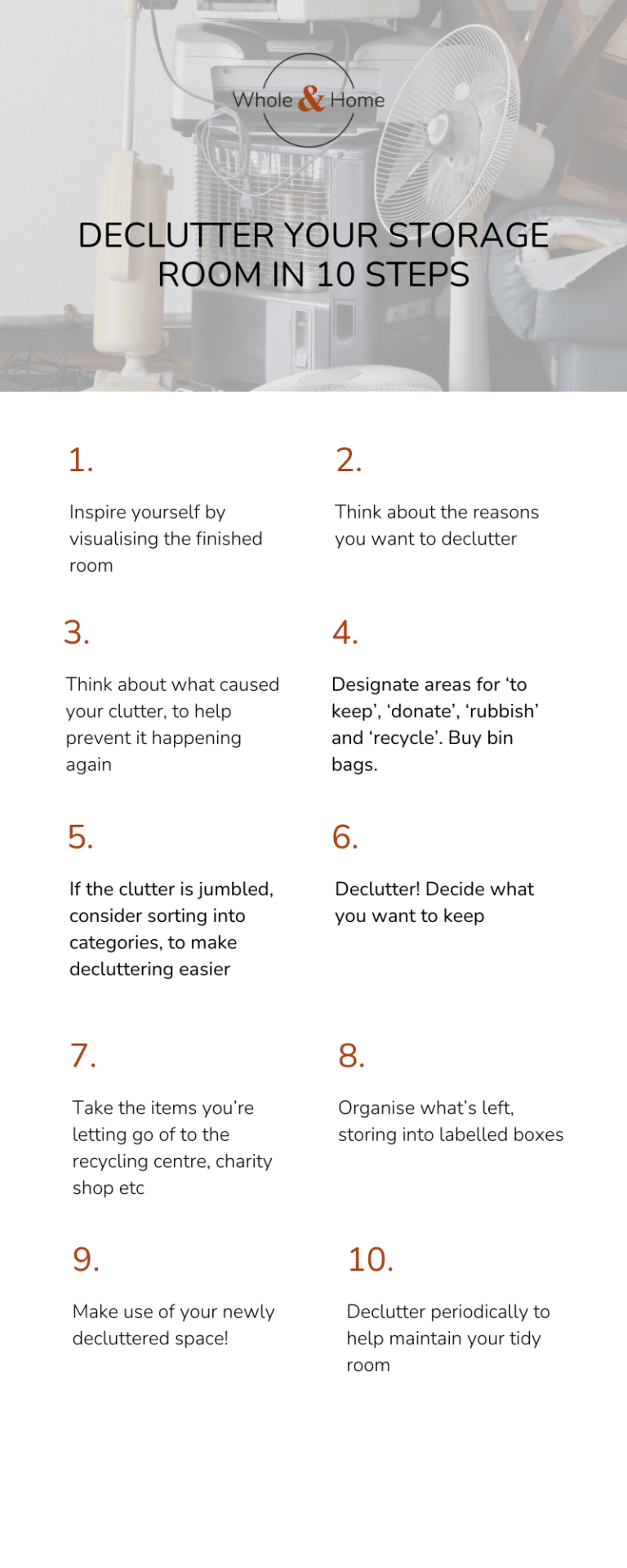Is there a room in your home that you use for storage? Common candidates are lofts, garages, spare rooms and utility rooms.
Even those with the tidiest of homes have a junk room. It’s the room we dump stuff in that we no longer want. It’s the room where we keep things we don’t currently need but might one day.
If your storage room is out of hand, it’s time to declutter. And the perfect place to start is by reading this post!
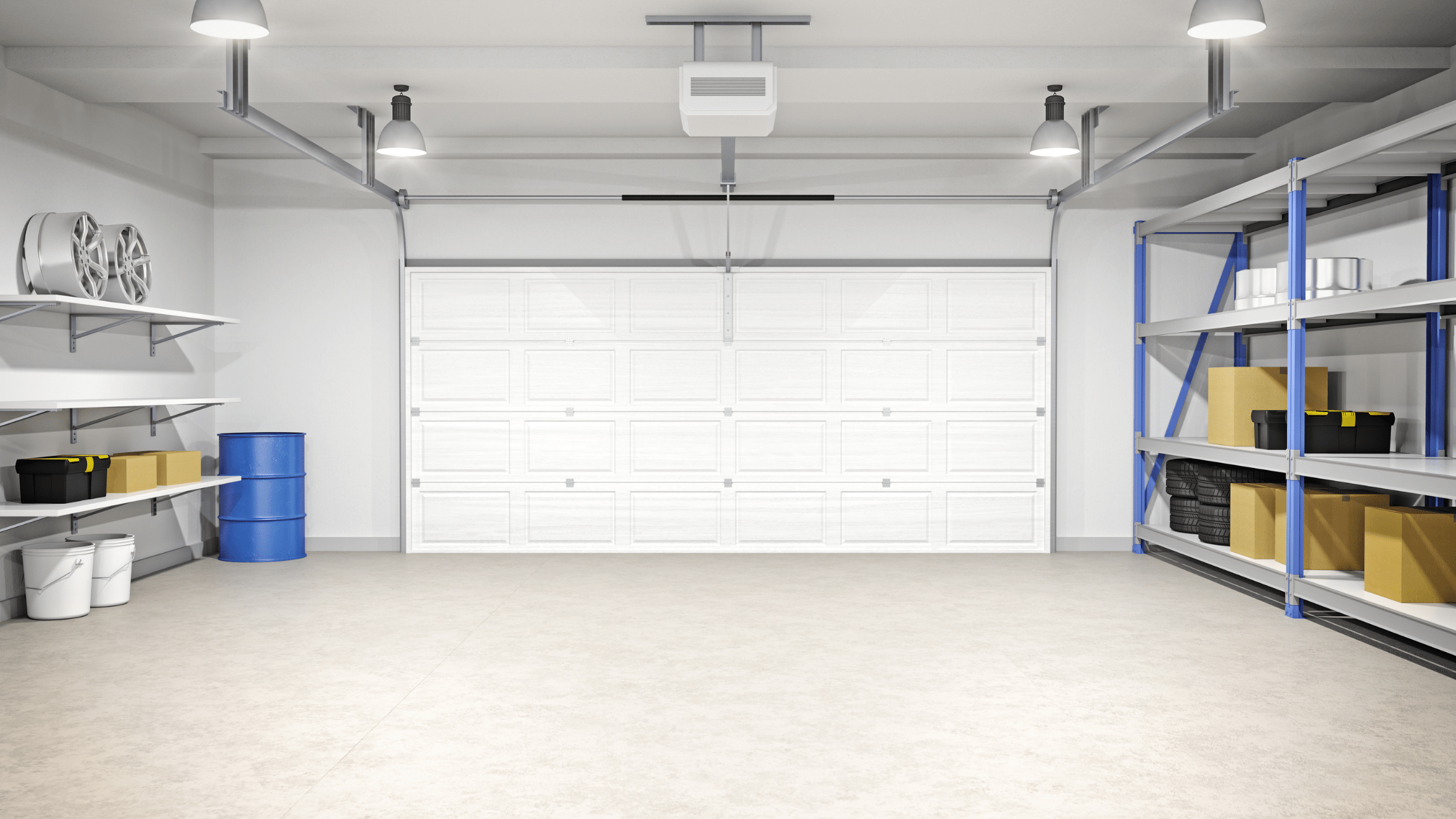
10 steps to a decluttered storage room
1. Get inspired (but don’t buy storage yet)
The first step is to motivate and inspire yourself.
Imagine your storage room fully decluttered and organised. You’re most likely picturing a load of neatly labelled stylish storage boxes. Get on Pinterest or Instagram if you need some inspiration.
But don’t order storage boxes yet. I’m speaking from experience here. It’s better to see what you have before you plan how to store it! If you buy boxes before you start, chances are you won’t need them and they become another thing to declutter! Save them as a reward for decluttering instead!
2. Why do you want to declutter?
Now that you are visually motivated, ask yourself why you want to declutter.
You want your room back!
Do you want to use the space for something else? Do you want your spare room back so you can finally invite guests to stay? Do you want to use your garage to store your new bicycle and need it tidy enough that you have easy access? Do you want to convert your loft but need to clear it first?
Perhaps you’re just sick of seeing the clutter and knowing it’s there.
How clutter affects us
Clutter affects us mentally. I worked with one client for months clearing her loft. When we were finished, she said it felt like a weight had been lifted from her. Lofts are a funny one clutter-wise, as although we don’t often see the clutter, the room sits above us, its contents like a cloud hanging over us. We know it’s there. It feels so good finally dealing with it!
You want to know what you’ve got
Another simple reason for decluttering your storage space is so you can see what’s there. Looking through your things periodically is a walk down memory lane. It feels good to know exactly what you have and where it is! It prevents us from buying more things unnecessarily and makes us feel in control.
Decluttering is hard. When you start lagging, picture the finished space and remind yourself of your whys.
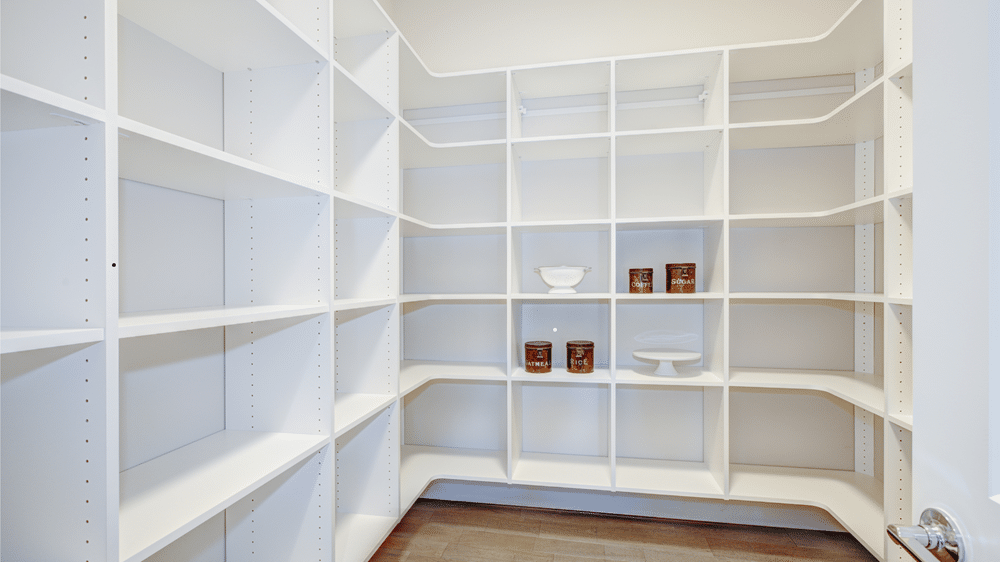
3. What caused your clutter?
Finally (and yes, we’ll start the decluttering very soon, I promise), it helps to consider how the clutter got there.
Common reasons for storage room clutter:
- You moved house or renovated, unpacked and left your non-essentials in a spare room, never to be unboxed.
- Your child moved out and left all their stuff behind. If this is the case, I’d try giving them a deadline and offer to help them go through things if they need the support.
- Someone has died and you’ve taken in their belongings.
- You’ve decluttered previously and these bags are all destined to be sold or donated. Only it’s been so long that you don’t remember what’s in there so you need to go through them again.
- You tidied a room in your house and had some bits you no longer want to keep in that room, but you have nowhere else to put it. You temporarily move it into the space room, loft or garage, and it stays there for the rest of time.
- The most common one: You no longer have a use for something right now, but you feel you may in future, so you put it into your store room. Repeat, repeat, repeat!
There are too many reasons why clutter accumulates to cover them all here. Suffice to say, it’s common. Life gets in the way. I understand!
The above might seem irrelevant – the clutter is there, it doesn’t matter how it got there, right? Well, not quite. Despite the varying reasons why clutter accumulates in storage rooms, they all share a common thread: the clutter in your storage room is not central to your life today. We know this to be true because otherwise, it’ll be in one of your main rooms being looked at and used.
Read it again:
Your storage room clutter is not a core part of your life!
Understand this and you’ll see that your clutter is not overly important. This should make it easier for you to let go of.
With that in mind, let’s begin.
4. Prepare yourself physically
Hopefully, by now, you should:
a) Feel more inspired to declutter your storage room
b) Have a better understanding of your relationship with clutter – not just to make it easier for you to let go of items, but to help prevent clutter build-up in future
Now it’s time for the physical prep.
All you need is:
- Some bin bags
- Stronger bags for life or boxes for charity shop items
- Energising food and drinks
- Music, if you find it motivates you (some, including me, find it distracting)
- To set a time in your calendar to start (if not today)
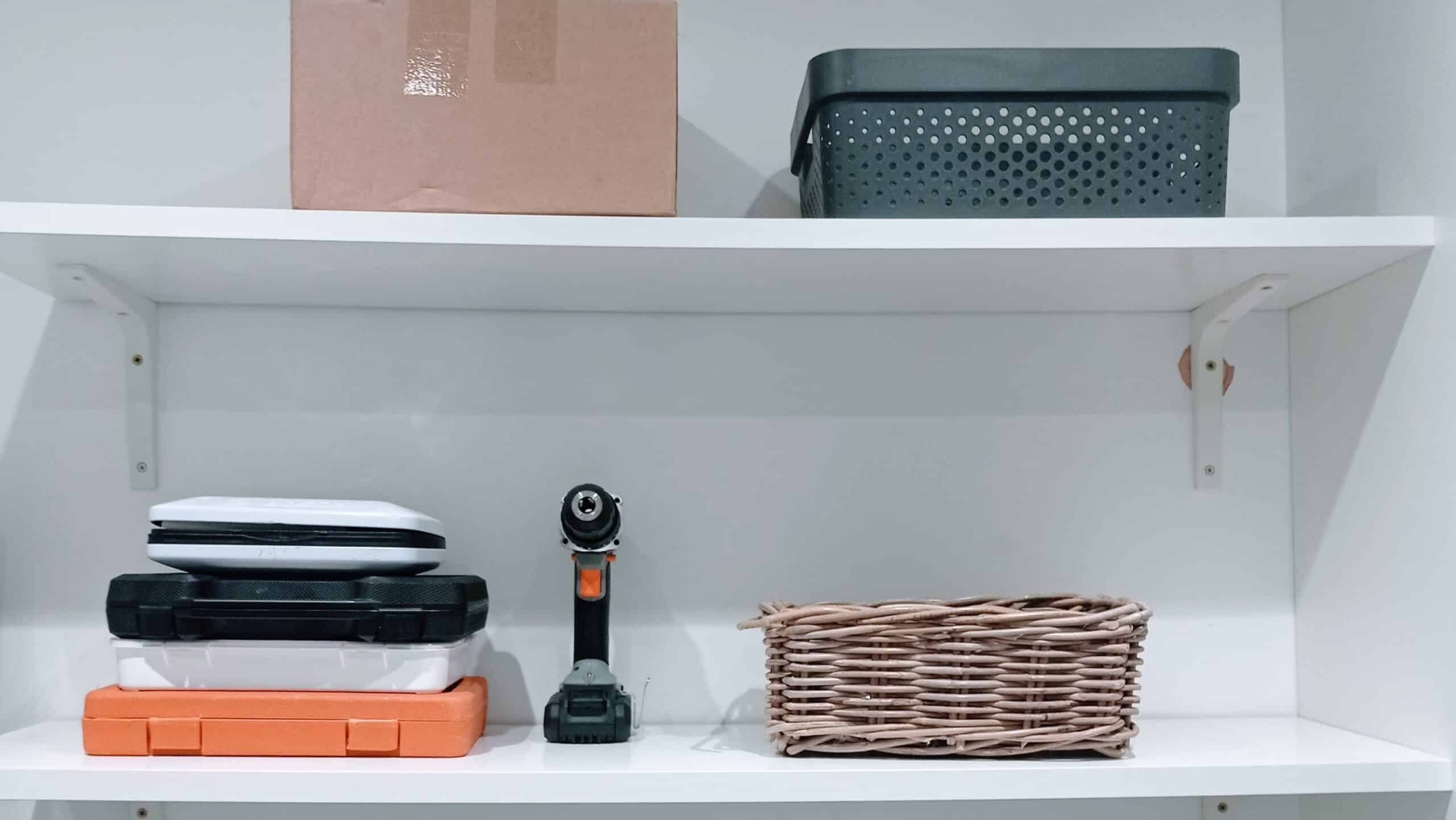
5. Sort into categories
If your things are already in rough categories (for example, a box of CDs, a suitcase of clothes), great. You can begin to declutter by category.
If everything is a jumbled mess, you have two choices:
- Start decluttering, grouping all the items you want to keep as you go. This is the preferred method if you find letting go easy and you want to declutter quickly
- Group everything into categories before you declutter. This is the method you should choose if you find letting go difficult.
If you chose option 1: Skip to the next step
If you chose option 2:
Sorting into categories first allows you to compare items as you declutter, so it’s easier to decide what to keep. If you can see you’ve got 10 pairs of sandals, you know that’s too many. You can see how their condition compares, which are similar and which could be easily replaced by another pair.
Sorting into categories first will also make the room tidier and make you feel calmer as you approach decluttering. Plus, if you don’t have time to decide on everything, at least it’s organised.
Do a quick declutter as you sort
As you sort into categories, if anything stands out to you as something you no longer want, feel free to declutter it. You can do the same with things you want to keep. But you shouldn’t feel like you’re putting effort into decisions. What you keep or discard at this point should be obvious to you. If you find it hard to decide whether to keep something, simply put it in its correct category and move on.
Make sorting more fun
Because sorting requires little thought and can be tedious, I recommend you listen to uplifting music. This part can take hours and sometimes days, but it’s extremely valuable.
6. Declutter
Decluttering questions for storage items
Here are some questions you can ask yourself as you declutter your storage items:
- Have I used it in the last year or two?
- Will I use it in the next year or two?
- Could I replace it for less than £X?
- Does it mean anything to me sentimentally? If so, is the memory a good one?
- Do I have anything else that does the same job?
- Thinking of my end goal, do I have space to keep this?
If you have a lot of sentimental things but can’t store them all, pick a box and aim to fill it with sentimental items, stopping when it’s full. This way, you’ll choose your favourite things first, saving the best and letting go of the rest.
Remember to sort into categories as you go!
If you chose option 1 in the previous step and you’re sorting into categories as you declutter, don’t forget to do so. You could make piles, bags or boxes of each category. Whatever you do, don’t create another pile of jumbled up ‘keep’ items, as that’ll make your life more difficult and let’s face it, you’ll never get around to sorting it!
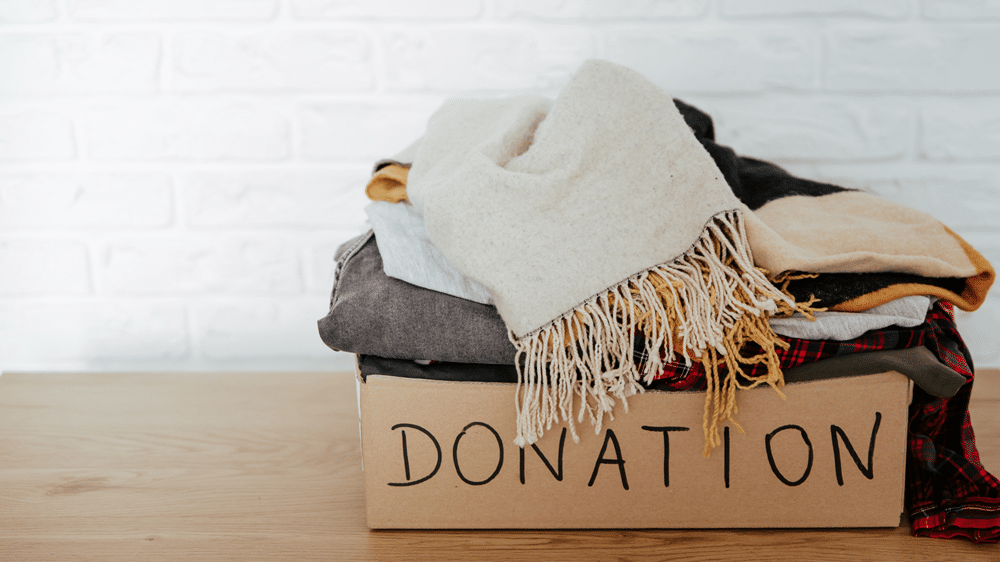
7. What to do with unwanted items
It may seem obvious, but process the items you’re decluttering as you go. Sort them into categories like rubbish, recycling, and charity shop. You might also have borrowed items you need to return or things that need fixing. You can put these in a box labelled ‘to action’.
Should I sell things I’m decluttering?
You might be tempted to sell your unwanted things. Selling can be a great way of making extra cash, but if you’re a busy person, I’d recommend you donate most of it and only sell the most expensive items. Weigh up the cost of your time against the money you’d make.
Should I regift?
Another popular way of discarding is to re-gift. I’d avoid doing this unless you know the person would like the item, or else you’ll be passing the problem of clutter onto them. As a general rule, only give something to someone if you’ve heard them mention that they like it or need something like it.
Try to avoid keeping hold of things you’re going to regift. Keeping a bag of toddler clothes for your sister’s baby to grow into is kind, but it takes up your physical and mental space. If possible, pass them on now.
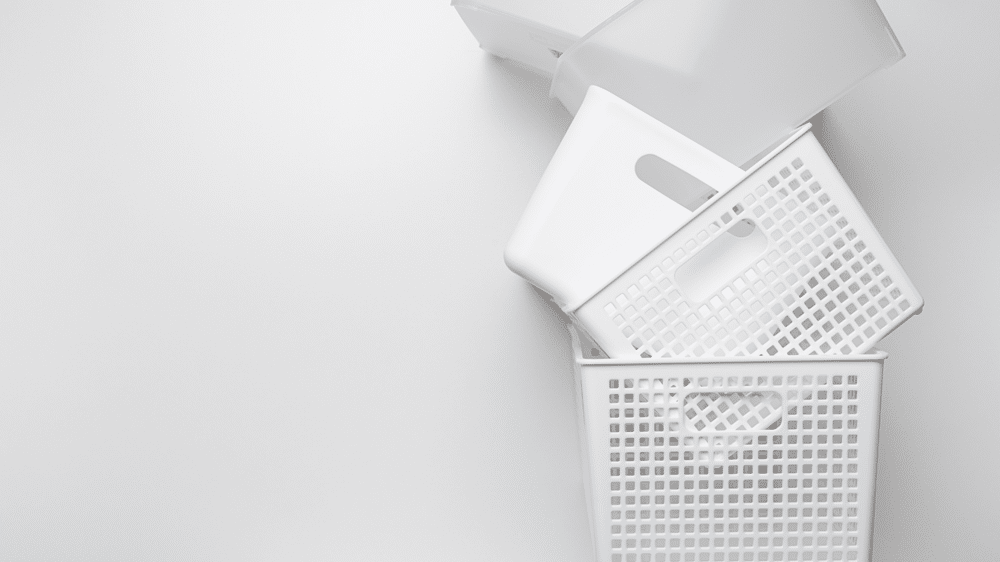
8. Organise your storage room
If you sorted things by category, it should be easy to organise. If you didn’t, do it now.
Choosing storage
Items should be stored in suitable containers and clearly labelled. Clear containers are popular with many as you can quickly see what’s in them.
Don’t go overboard creating categories, especially at this stage. Getting things into boxes such as ‘photos’, and ‘kids clothes’ ensures you finish the job. If you want to go back and create further categories later, feel free. The exception to this rule is if you have mostly kids’ clothes in your storage. Then, of course, you’d want to sort them into ages.
—
One of the biggest setbacks my clients face is wanting to do everything perfectly the first time, as it makes the task seem so big they never get around to starting it, and if they do, they rarely get around to finishing.
—
Rehoming items
If some items are to be distributed around your house rather than stored, do that now.
9. Enjoy the extra space!
If you decluttered a spare room with a view using it for another purpose, do so. Create your dream spare bedroom, workspace, or whatever you intend to use it for.
Making the room nice and using it for its intended purpose will help prevent you from cluttering it again.
10. Revisit and revise
Sadly, you’ll still need to declutter your storage room periodically to stay on top of things.
How often you do this will depend on how much you add over time.
If you’re frequently adding more things, then a good goal is to go through it all every year or two. If you’re not adding much, every 5-10 years might be enough.
You can also factor in how often you want to look through your things. You might have a box you know will be needed at a certain time.
However frequently you decide to approach it, keeping on top of it is key to making sure it stays tidy.
Need a helping hand with your garage, loft or storage room? Get in touch for a free chat about what we can do together.
